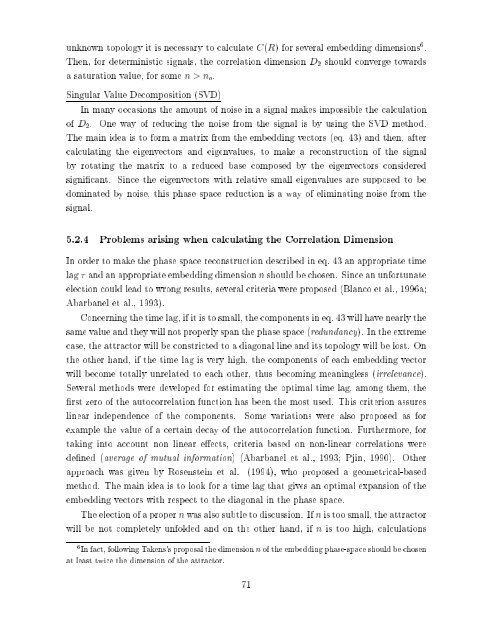Quantitative analysis of EEG signals: Time-frequency methods and ...
Quantitative analysis of EEG signals: Time-frequency methods and ...
Quantitative analysis of EEG signals: Time-frequency methods and ...
Create successful ePaper yourself
Turn your PDF publications into a flip-book with our unique Google optimized e-Paper software.
unknown topology it is necessary to calculate C(R) for several embedding dimensions 6 .<br />
Then, for deterministic <strong>signals</strong>, the correlation dimension D 2 should converge towards<br />
a saturation value, for some n>n o .<br />
Singular Value Decomposition (SVD)<br />
In many occasions the amount <strong>of</strong>noisein a signal makes impossible the calculation<br />
<strong>of</strong> D 2 . One way <strong>of</strong> reducing the noise from the signal is by using the SVD method.<br />
The main idea is to form a matrix from the embedding vectors (eq. 43) <strong>and</strong> then, after<br />
calculating the eigenvectors <strong>and</strong> eigenvalues, to make a reconstruction <strong>of</strong> the signal<br />
by rotating the matrix to a reduced base composed by the eigenvectors considered<br />
signicant. Since the eigenvectors with relative small eigenvalues are supposed to be<br />
dominated by noise, this phase space reduction is a way <strong>of</strong> eliminating noise from the<br />
signal.<br />
5.2.4 Problems arising when calculating the Correlation Dimension<br />
In order to make the phase space reconstruction described in eq. 43 an appropriate time<br />
lag <strong>and</strong> an appropriate embedding dimension n should be chosen. Since an unfortunate<br />
election could lead to wrong results, several criteria were proposed (Blanco et al., 1996a<br />
Abarbanel et al., 1993).<br />
Concerning the time lag, if it is to small, the components in eq. 43 will have nearly the<br />
same value <strong>and</strong> they will not properly span the phase space (redundancy). In the extreme<br />
case, the attractor will be constricted to a diagonal line <strong>and</strong> its topology will be lost. On<br />
the other h<strong>and</strong>, if the time lag is very high, the components <strong>of</strong> each embedding vector<br />
will become totally unrelated to each other, thus becoming meaningless (irrelevance).<br />
Several <strong>methods</strong> were developed for estimating the optimal time lag, among them, the<br />
rst zero <strong>of</strong> the autocorrelation function has been the most used. This criterion assures<br />
linear independence <strong>of</strong> the components. Some variations were also proposed as for<br />
example the value <strong>of</strong> a certain decay <strong>of</strong> the autocorrelation function. Furthermore, for<br />
taking into account non linear eects, criteria based on non-linear correlations were<br />
dened (average <strong>of</strong> mutual information) (Abarbanel et al., 1993 Pjin, 1990). Other<br />
approach was given by Rosenstein et al. (1994), who proposed a geometrical-based<br />
method. The main idea is to look for a time lag that gives an optimal expansion <strong>of</strong> the<br />
embedding vectors with respect to the diagonal in the phase space.<br />
The election <strong>of</strong> a proper n was also subtle to discussion. If n is too small, the attractor<br />
will be not completely unfolded <strong>and</strong> on the other h<strong>and</strong>, if n is too high, calculations<br />
6 In fact, following Takens's proposal the dimension n <strong>of</strong> the embedding phase-space should be chosen<br />
at least twice the dimension <strong>of</strong> the attractor.<br />
71




